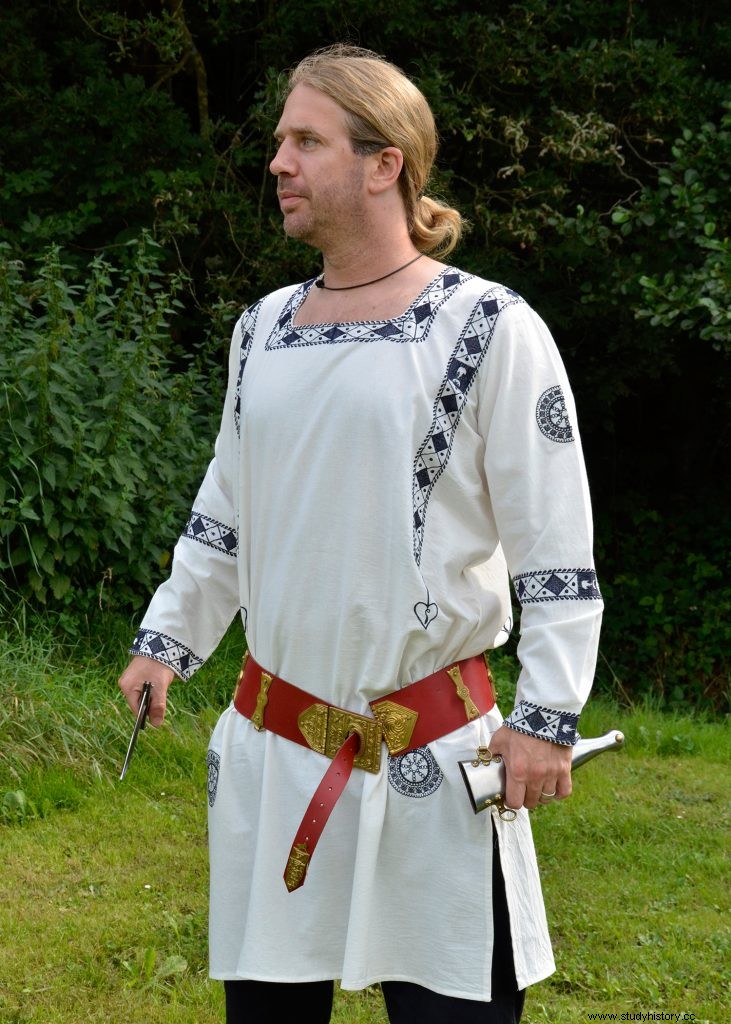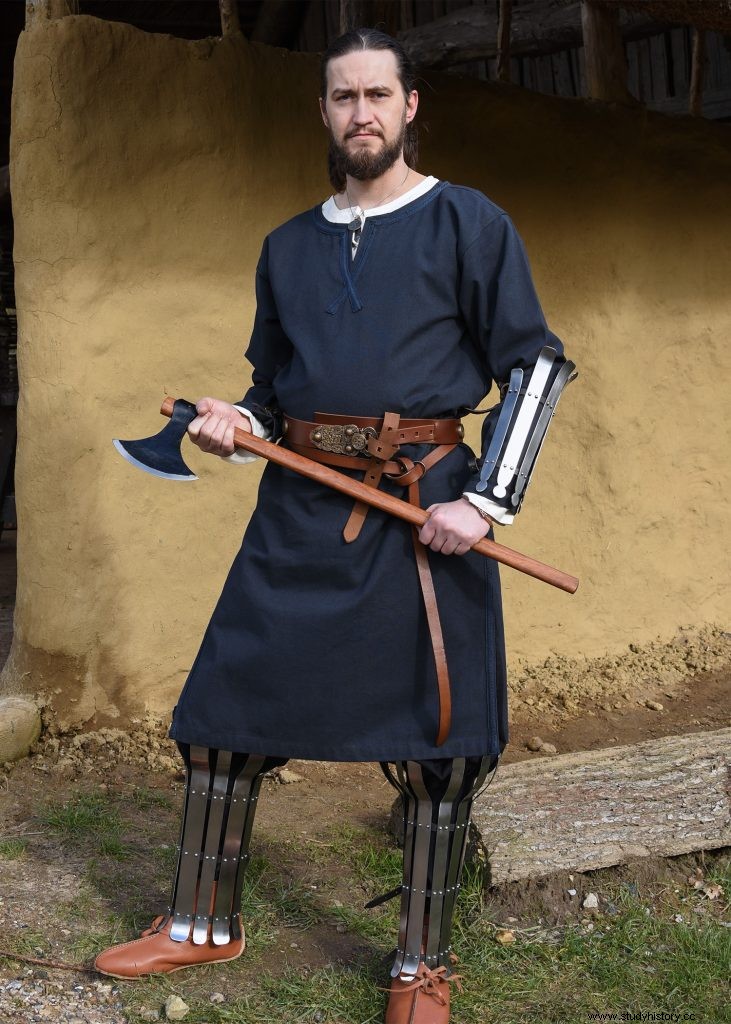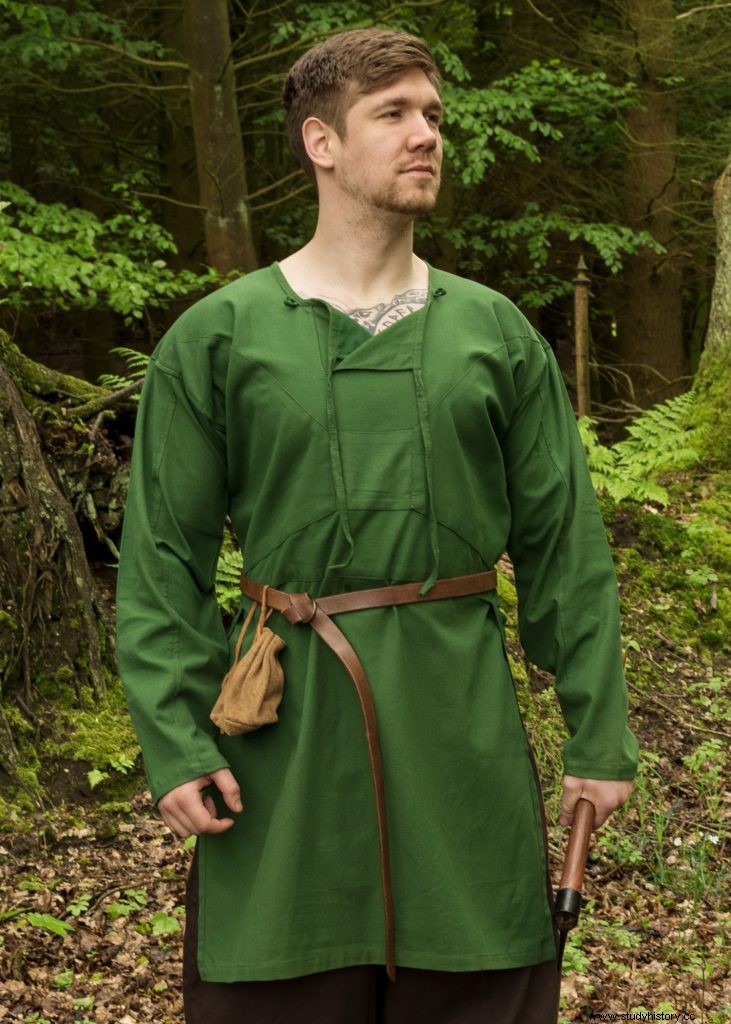It is one of the most well-known items of clothing since antiquity:the tunic. Thanks to its simple cut and versatility, it has been worn by men, women and children for many centuries. Even modern fashion designers use this traditional cut in their collections. A look at the long history of the tunic shows why it was so popular and what is known about its development.
Fun facts about the tunic:origins and history
The term tunic comes directly from Latin. Among the Romans, the so-called tunica was worn by men, women and children primarily as an undergarment under the toga. As a rule, it was made of white wool, later also of linen. So that it was not bulky, it was narrower than the outer garment and had slits on the sides. It came down to about the knee. Outside the home, the tunic (also called cotte) was tied with a belt. Roman tunics often had vertical stripes for decoration, the so-called clavi. From the later imperial period, further ornamental strips were added. The tunica interior was a simple undershirt that was worn under the tunica. Tunics were also used as the main clothing by slaves, workers and peasants, as can be seen on reliefs and frescoes. The Roman tunic probably originated from the Greek chiton. This originally consisted of two loose strips of fabric that were only stapled together at one shoulder.
The tunic was not only a common item of clothing for the Romans. Paintings, sculptures, illustrations and funerary objects show that the garment was worn throughout what is now Europe and beyond. It is not always clear whether this is a similar piece of clothing from one's own culture or a direct adoption from the Romans. Both the Celts and the Germans wore shirts that resembled a Roman tunic over their trousers. They served as undergarments for women. Unlike the Roman counterparts, these garments usually had short or longer sleeves to provide more protection in colder regions. Findings in Hedeby (Haithabu) and Birka prove that Vikings also knew tunics. An even older tunic (ca. 300 AD) was also found in a Norwegian glacier near Breheimen.
The tunic remained a common garment in Europe and the Byzantine Empire until the late Middle Ages. Length and designs varied. From the 12th century, the garment was increasingly worn as an outer garment. This development led to more and more magnificent tunics being produced in addition to the simple ones. Because aristocratic citizens, dignitaries and clergy liked to dress in colourful, elaborately decorated silk fabrics.



Efficient and economical:the cut of the tunic
The basic shape of the tunic is very simple:it consists of two rectangular panels of fabric that are held together at the shoulders. Primers, for example, are suitable for this. Alternatively, the two cloths can be stapled together with just a few stitches. Already with the Romans the tunic was sewn together on the sides. This cut is characterized by several decisive advantages. Fabric comes off the loom as a rectangular web. Processing them in this form eliminates the need for complicated trimming. This saves time and ensures that all the material can be processed. In addition, it is very easy to adapt a tunic to the body measurements of the respective person. The garment can be made short, knee-length or long, as desired. After all, the straight, no-frills tunic cut is ideal for making everyday clothing out of simple, coarse fabrics.
Even the slightly more elaborate cut with short or long sleeves is relatively easy to make compared to other garments. First, the sleeveless version is made. Straight sleeves are then sewn on in the shoulder area. This creates the typical T-shape of a tunic. More elaborate models can have a more comfortable cut, with gussets (rectangular pieces of fabric) in the armpit area and mitres (wedge-shaped pieces of fabric) in the skirt area for more freedom of movement.
Fine fabrics are much better suited for this type of sewing work than coarse material.



Fabric making:an everyday household activity
In ancient times and the Middle Ages, buying fabrics and clothing was reserved for the wealthy. Those who had the opportunity made their own clothes. For this, fibers of animal or plant origin were processed. Wool or linen were common fabrics. However, in addition to the raw materials, suitable tools are required for the production of both types of material. Flax, nettle and hemp fibers are suitable for the production of fabrics. Which plant species are available in a specific location depends on the soil, the water supply and the weather conditions. The extraction of flax fibers is labor intensive. After several work steps, just under 10% of the harvest weight is available as spinnable fibre. Hemp is a little easier to process.
Just like the plant fibers, wool has to go through several work processes before it can be further processed. This includes cleaning, drying, beating, re-greasing if necessary and combing. Depending on the breed of sheep and how it is kept, there are different qualities and colors of wool. The fur of sheep from the northern areas usually has two different types of hair. The warming undercoat, from which fine wool fabrics can be obtained, is close to the body. The strong outer fur, the hair of which results in a coarser fabric, protects against the cold and wet.
The further processing steps for animal and plant fibers differed little in the Middle Ages. Spinning was the next step. The easiest - and before the invention of the spinning wheel the only - method was spinning by hand. With the help of a spindle, the individual plant fibers were processed into yarn. Fabrics for tunics and other garments were then created on a loom or loom.
The Viborg tunic:This is what the well-to-do people wore
In 1984, archaeologists digging in Denmark made a fascinating find. In the area of the former Viking settlement Viborg Sødersø they discovered the remains of an elaborate tunic that can be dated to the first half of the 11th century. The scientists used the parts to reconstruct the interesting piece of clothing.

It is a long-sleeved linen shirt with a length of approximately 95 cm. A laboratory analysis showed that the fabric was not dyed. The elaborate processing of the body part is remarkable. The front and back are made of one piece (no shoulder seams), but the upper part is double-layered. A kind of inner lining was additionally quilted here. Side slits begin below the waist. The square collar opening has slits and ties. Several pattern pieces were used for the sleeves. They are finished to fit comfortably and taper towards the wrist. In total, the scientists found eight different types of seams on the Viborg tunic.
Due to the elaborate cut of the tunic and the high amount of fabric used, it can be assumed that this piece of clothing belonged to a well-to-do personality.
